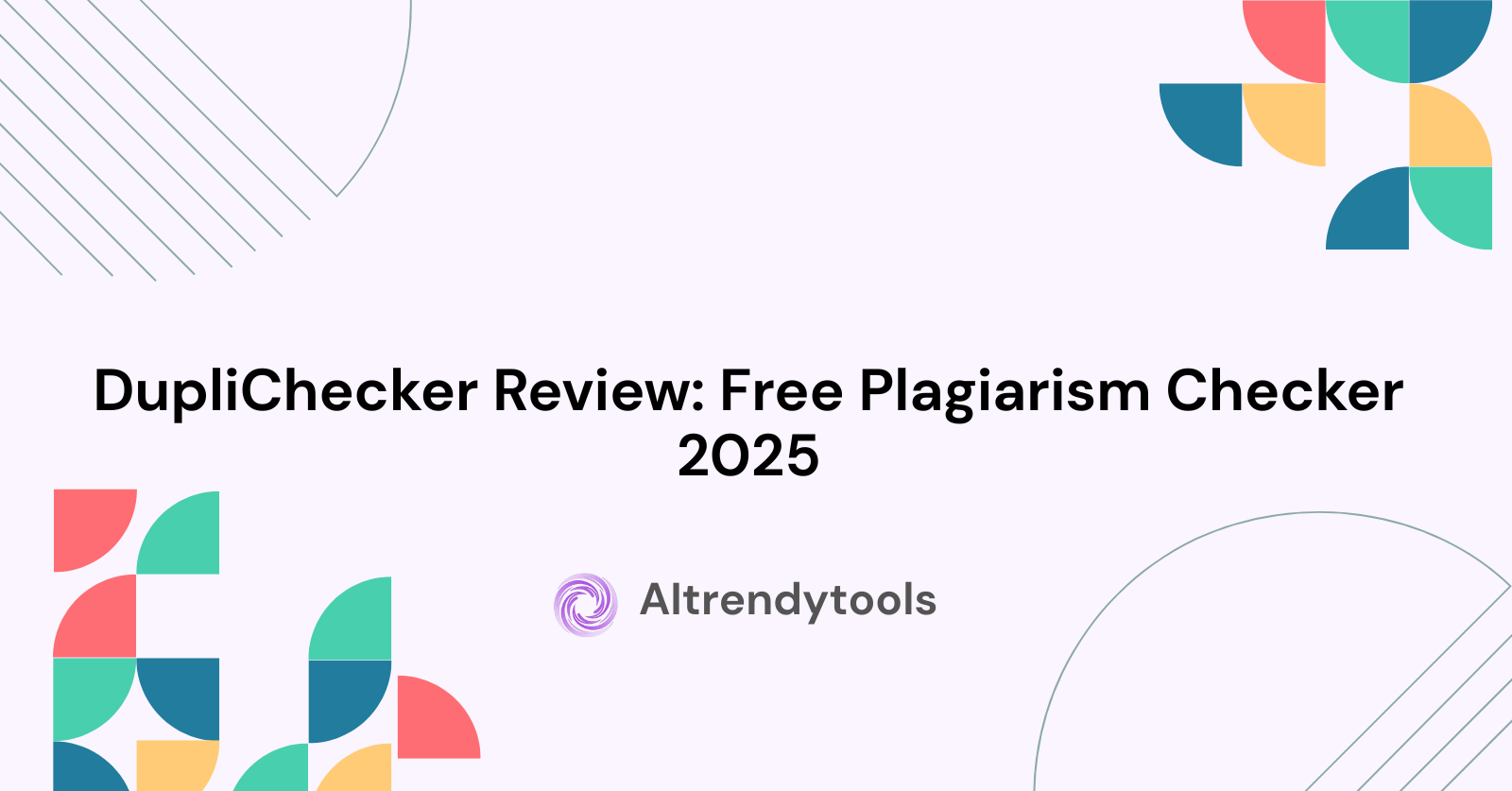🔥 AITrendytools: The Fastest-Growing AI Platform |
Write for usDupliChecker Review: Free Plagiarism Checker 2025
Complete DupliChecker guide: Free plagiarism detection, accuracy review, features comparison. Best Practices for Students and Content Creators.
Jul 4, 2025
DupliChecker Review: Free Plagiarism Checker 2025
Academic integrity and content originality have become more critical than ever in our digital world. Whether you're a student submitting assignments, a blogger creating content, or a professional writer developing articles, ensuring your work is plagiarism-free is essential. This comprehensive guide explores DupliChecker, one of the most popular free plagiarism detection tools available today.
DupliChecker has emerged as a reliable solution for millions of users worldwide who need quick and accurate plagiarism detection without breaking the bank. The platform offers both free and premium services, making it accessible to everyone from students to professional content creators. Understanding how this tool works and maximizing its potential can significantly improve your content quality and academic standing.
What is DupliChecker
DupliChecker is an online plagiarism detection tool that uses artificial intelligence to scan text and identify potential instances of copied content. The platform was designed to help users maintain content originality by comparing submitted text against a vast database of online sources, academic papers, and published materials.
The tool operates on a simple principle: it analyzes your text and searches for matching phrases, sentences, or paragraphs across the internet. When similarities are found, DupliChecker highlights the problematic sections and provides the percentage of plagiarized content. This straightforward approach makes it easy for users to identify areas that need revision or proper citation.
What sets DupliChecker apart from many competitors is its commitment to providing free access to plagiarism detection services. While many platforms require subscriptions or charge per scan, DupliChecker offers a substantial free tier that meets the needs of most casual users. The platform also provides additional writing tools, including grammar checkers and paraphrasing tools, creating a comprehensive writing assistance ecosystem.
Free Plagiarism Checker Features
DupliChecker's free plagiarism checker comes packed with features that make it attractive to users across different categories. The platform allows users to check up to 1,000 words per scan in the free version, which is sufficient for most academic assignments, blog posts, and professional documents.
The free version includes several input methods for user convenience. You can copy and paste text directly into the tool, upload documents in various formats including DOC, DOCX, and TXT files, or even input a URL to check web content for plagiarism. This flexibility ensures that users can work with their preferred document formats without additional conversion steps.
Real-time scanning capabilities mean you receive results within seconds of submitting your content. The tool generates a detailed report showing the percentage of plagiarized content, highlighted problematic sections, and source links where similar content was found. This immediate feedback allows for quick revisions and improvements to your work.
The free version also includes basic grammar checking functionality, helping users identify common grammatical errors alongside plagiarism issues. This dual-purpose approach saves time and ensures that your content is both original and well-written.
Premium Features and Pricing
While the free version of DupliChecker serves most users well, the premium version offers enhanced capabilities for those who need more comprehensive plagiarism detection. The premium plan increases the word limit to 25,000 words per scan, making it suitable for longer academic papers, research documents, and extensive content pieces.
Premium users gain access to an expanded database that includes more academic sources, professional publications, and specialized content repositories. This broader coverage increases the accuracy of plagiarism detection and helps identify matches that might be missed in the free version.
Advanced reporting features in the premium version provide more detailed analysis of plagiarized content. Users receive comprehensive reports with statistical breakdowns, similarity scores for different sources, and suggestions for improvement. These detailed insights help users understand their writing patterns and make targeted improvements.
The premium version also removes advertisements from the interface, creating a cleaner working environment. Priority processing ensures faster results during peak usage times, while enhanced customer support provides assistance when needed.
How to Use DupliChecker
Using DupliChecker is straightforward and requires no technical expertise. The platform's user-friendly interface guides users through the plagiarism checking process step by step.
Start by visiting the DupliChecker website and locating the plagiarism checker tool. The main interface presents several options for submitting your content. You can either paste your text directly into the provided text box, upload a document from your computer, or enter a URL if you want to check web content.
Once you've submitted your content, click the "Check Plagiarism" button to initiate the scanning process. The tool will analyze your text and compare it against its database of sources. This process typically takes a few seconds to complete, depending on the length of your content and current server load.
After the scan completes, DupliChecker presents your results in an easy-to-understand format. The overall plagiarism percentage appears prominently at the top of the results page. Below this, you'll find your original text with highlighted sections indicating potential plagiarism matches.
Each highlighted section includes information about the source where similar content was found. You can click on these sources to visit the original pages and verify the matches. This transparency helps you make informed decisions about whether the flagged content requires revision or proper citation.
DupliChecker Accuracy and Reliability
The accuracy of any plagiarism detection tool depends on several factors, including database size, algorithm sophistication, and update frequency. DupliChecker performs well in these areas, though like all free tools, it has certain limitations compared to premium academic plagiarism checkers.
DupliChecker's database includes millions of web pages, academic papers, and published documents. The platform continuously updates its database to include new content, ensuring that recent publications and web pages are included in plagiarism scans. However, the database may not be as comprehensive as premium services like Turnitin, which have access to proprietary academic databases.
The tool's AI-powered algorithms are designed to identify not just exact matches but also paraphrased content and near-duplicate text. This capability helps catch more sophisticated forms of plagiarism where authors have attempted to disguise copied content through minor modifications.
Real-world testing shows that DupliChecker successfully identifies obvious plagiarism cases and provides reliable results for most academic and professional writing scenarios. The tool performs particularly well with web content detection, as it has extensive coverage of online sources.
Users should understand that no plagiarism checker is 100% perfect, and DupliChecker is no exception. The tool may occasionally flag legitimate content as plagiarism (false positives) or miss some instances of copied content (false negatives). Critical documents should be checked with multiple tools or verified manually for complete accuracy.
Comparison with Other Plagiarism Checkers
The plagiarism detection market includes numerous tools, each with distinct advantages and limitations. Understanding how DupliChecker compares to alternatives helps users make informed decisions about which tool best meets their needs.
Grammarly is perhaps the most well-known competitor, offering plagiarism detection alongside comprehensive grammar and style checking. While Grammarly provides more advanced writing assistance features, DupliChecker focuses specifically on plagiarism detection and offers more generous free usage limits.
Turnitin remains the gold standard for academic plagiarism detection, with extensive databases and sophisticated algorithms. However, Turnitin is primarily available through educational institutions and comes with significant costs. DupliChecker provides a more accessible alternative for individual users who need reliable plagiarism detection without institutional access.
Copyscape specializes in web content plagiarism detection and is popular among bloggers and content creators. While Copyscape excels at detecting online content duplication, DupliChecker offers broader functionality with additional writing tools and document format support.
Quetext provides another free alternative with modern interface design and good detection capabilities. Both DupliChecker and Quetext offer competitive free tiers, though they differ in their specific features and database coverage.
SmallSEOTools offers a free plagiarism checker with similar capabilities to DupliChecker. The choice between these tools often comes down to personal preference regarding interface design and additional features offered by each platform.
Best Practices for Plagiarism Detection
Effective plagiarism detection requires more than just running your content through a checking tool. Understanding best practices helps ensure comprehensive protection against accidental plagiarism and maintains the integrity of your work.
Check your content at multiple stages of the writing process rather than only at the end. Early detection of plagiarism issues allows for easier revision and prevents the frustration of major rewrites after completing your work. Consider running preliminary checks on individual sections or chapters as you write.
Use multiple plagiarism detection tools when possible, especially for important documents. Different tools have varying database coverage and detection algorithms, so using multiple checkers increases the likelihood of catching all potential issues. DupliChecker can serve as your primary tool, with secondary checks using alternatives like Grammarly or Quetext.
Understand the difference between plagiarism and proper citation. Plagiarism checkers may flag legitimately cited content as potential plagiarism if the citation format is incorrect or if the quoted material is extensive. Review flagged content carefully to determine whether it requires revision or simply better citation practices.
Keep detailed records of your sources throughout the research and writing process. Maintaining a bibliography or reference list from the beginning helps prevent accidental plagiarism and makes it easier to add proper citations when plagiarism checkers identify potential issues.
Learn to interpret plagiarism reports effectively. Not all flagged content represents actual plagiarism - common phrases, technical terms, and widely-used expressions may be flagged despite being acceptable. Develop the judgment to distinguish between problematic plagiarism and acceptable similarity.
Student Guide to Academic Integrity
Students face unique challenges in maintaining academic integrity while completing assignments and research papers. DupliChecker can be an valuable tool in this process, but understanding how to use it effectively within academic contexts is crucial.
Many educational institutions have specific policies regarding plagiarism checkers and self-checking before submission. Some schools encourage students to use tools like DupliChecker to verify their work, while others prefer that students submit original work without pre-checking. Familiarize yourself with your institution's policies before using any plagiarism detection tool.
Academic writing often involves building upon existing research and ideas, which can create challenges in plagiarism detection. Learn to distinguish between necessary academic citation and problematic copying. DupliChecker may flag properly cited sources, but this doesn't necessarily indicate plagiarism if the citation is correct and the use is appropriate.
Develop good note-taking habits that help prevent accidental plagiarism. When researching, clearly distinguish between your own ideas, paraphrased content, and direct quotes. This organization makes it easier to write original content and properly cite sources where necessary.
Understand that plagiarism checkers like DupliChecker are tools to help improve your work, not shortcuts to avoid learning proper writing and citation skills. Use the tool to identify potential issues, but invest time in understanding why those issues exist and how to address them properly.
Content Creators and Bloggers
Professional content creators and bloggers have specific needs when it comes to plagiarism detection. Maintaining original content is essential for SEO performance, professional credibility, and legal compliance.
Search engines prioritize original content in their rankings, making plagiarism detection crucial for online success. DupliChecker helps content creators ensure their work is unique and won't be penalized by search algorithms that detect duplicate content.
Regular plagiarism checking should be part of your content creation workflow. Check your work before publication to avoid potential issues with clients or search engines. Many professional writers use DupliChecker as a final quality control step before submitting content.
Understand the legal implications of plagiarized content in professional contexts. Copying content without permission can result in copyright infringement claims, damaged professional relationships, and legal consequences. DupliChecker helps protect against these risks by identifying potential issues before publication.
Consider using plagiarism detection tools to verify the originality of content you receive from freelance writers or contributors. If you manage a team of writers or work with external content creators, regular plagiarism checking helps maintain quality standards and protects your brand reputation.
Grammar Checker Integration
DupliChecker's integrated grammar checker provides additional value beyond plagiarism detection. This dual functionality makes it a comprehensive writing assistance tool for users who want to improve both originality and quality.
The grammar checker identifies common writing errors including spelling mistakes, punctuation errors, and basic grammatical issues. While not as sophisticated as dedicated grammar tools like Grammarly, it provides sufficient feedback for most writing scenarios.
Using both features together creates an efficient workflow for content improvement. You can check for plagiarism and grammar issues simultaneously, saving time and ensuring comprehensive content review. This integrated approach is particularly valuable for students and professionals working under tight deadlines.
The grammar checker helps improve the overall quality of your writing, which can indirectly help with plagiarism issues. Well-written, properly structured content is less likely to inadvertently match existing sources, as it reflects your unique voice and writing style.
Remember that grammar checkers are tools to assist your writing, not replace careful proofreading and editing. Use DupliChecker's grammar features as a starting point for improvement, but don't rely solely on automated feedback for critical documents.
AI Detection Capabilities
Modern plagiarism detection increasingly includes AI-generated content identification, and DupliChecker has adapted to address this emerging need. As AI writing tools become more prevalent, the ability to detect artificially generated content becomes increasingly important.
DupliChecker's AI detection features help identify content that may have been generated using tools like ChatGPT, Claude, or other language models. This capability is particularly important in academic contexts where original human writing is required.
The AI detection algorithms analyze writing patterns, sentence structure, and content characteristics that typically indicate machine-generated text. However, these systems are still evolving, and detection accuracy can vary depending on the sophistication of the AI tool used and the quality of the generated content.
Educational institutions and employers increasingly require disclosure of AI assistance in writing. DupliChecker's AI detection features help identify content that may require disclosure or revision to meet institutional requirements.
Understand that AI detection, like plagiarism detection, is not perfect. The technology continues to improve, but false positives and false negatives can occur. Use AI detection results as guidance rather than definitive proof of artificial generation.
Mobile and Desktop Applications
DupliChecker offers flexibility in how users access its services, with both web-based and mobile applications available. This accessibility ensures that users can check their content regardless of their preferred device or location.
The web-based version provides the most comprehensive feature set and is suitable for most users. It works well on both desktop and mobile browsers, though the desktop experience typically offers better visibility for reviewing results and managing longer documents.
Mobile applications provide convenient access to plagiarism checking for users who frequently work on smartphones or tablets. The mobile interface is optimized for smaller screens while maintaining essential functionality.
Consider your typical workflow when choosing between web and mobile access. If you primarily write on a computer, the web version offers the best experience. For users who frequently work on mobile devices or need to check content while away from their desk, the mobile application provides valuable flexibility.
The mobile application includes core plagiarism detection features but may have limitations compared to the full web version. Complex documents or advanced features may require using the desktop version for optimal results.
Advanced Tips and Tricks
Maximizing DupliChecker's effectiveness requires understanding advanced techniques and best practices that go beyond basic plagiarism checking. These strategies help experienced users get better results and work more efficiently.
Break large documents into smaller sections for more targeted checking. While DupliChecker can handle substantial content, checking individual sections or chapters allows for more focused analysis and easier revision of problematic areas.
Use the URL checking feature to verify the originality of web content before publishing. This capability is particularly valuable for bloggers and content creators who want to ensure their published content remains unique over time.
Experiment with different input methods to find what works best for your workflow. Some users prefer copying and pasting text for quick checks, while others find document upload more convenient for formal papers and longer content.
Save and organize your plagiarism reports for future reference. Keeping records of your checks can help track improvement over time and provide documentation of your commitment to academic integrity or content originality.
Learn to customize your checking approach based on content type. Academic papers may require more stringent checking than blog posts, while creative writing might need different consideration than technical documentation.
Common Mistakes to Avoid
Understanding common pitfalls in plagiarism detection helps users avoid problems and get more accurate results from DupliChecker. Avoiding these mistakes improves the effectiveness of your plagiarism checking process.
Don't rely solely on plagiarism percentage scores without reviewing the actual flagged content. A high percentage doesn't automatically indicate problematic plagiarism, just as a low percentage doesn't guarantee complete originality. Always review the specific matches identified by the tool.
Avoid checking content that includes extensive citations or references without understanding how this affects results. Properly cited content may still be flagged by plagiarism checkers, but this doesn't necessarily indicate a problem if the citations are correct.
Don't ignore false positives without proper consideration. While some flagged content may be acceptable, review each match to ensure you're not missing legitimate plagiarism issues. Common phrases and technical terms are often flagged despite being acceptable.
Avoid using plagiarism checkers as a substitute for learning proper citation and writing skills. These tools are meant to supplement good writing practices, not replace them. Invest time in understanding proper citation formats and original writing techniques.
Don't assume that all plagiarism checkers will give identical results. Different tools have varying databases and algorithms, so results can differ between platforms. Use this variation as additional information rather than confusion.
Future of Plagiarism Detection
The plagiarism detection industry continues to evolve rapidly, driven by advances in artificial intelligence, expanding databases, and changing academic and professional requirements. Understanding these trends helps users prepare for future developments.
AI and machine learning technologies are becoming more sophisticated in detecting both traditional plagiarism and AI-generated content. Future versions of tools like DupliChecker will likely offer improved accuracy and faster processing times.
Database expansion continues as more content becomes digitized and accessible. This growth improves detection capabilities but also increases the complexity of managing and searching vast amounts of information.
Integration with other writing and productivity tools is becoming more common. Plagiarism checkers may increasingly integrate with word processors, learning management systems, and content management platforms for seamless workflow integration.
Real-time checking capabilities may become standard, allowing users to receive plagiarism feedback as they write rather than after completing their work. This immediate feedback could help prevent plagiarism issues before they become problematic.
Privacy and security considerations will likely become more important as plagiarism checkers handle increasingly sensitive academic and professional content. Tools that prioritize user privacy and data security may gain competitive advantages.
Conclusion
DupliChecker represents a valuable resource for anyone concerned with content originality and plagiarism detection. Its combination of free access, comprehensive features, and user-friendly interface makes it an attractive option for students, professionals, and content creators alike.
The tool's strengths include its generous free tier, multiple input methods, and additional writing assistance features. While it may not match the database coverage of premium academic tools like Turnitin, DupliChecker provides sufficient accuracy for most users' needs.
Success with DupliChecker, like any plagiarism detection tool, requires understanding its capabilities and limitations. Users who combine the tool with good writing practices, proper citation techniques, and critical thinking about results will get the most benefit from the platform.
The future of plagiarism detection looks promising, with continued improvements in AI technology and database coverage. DupliChecker's commitment to providing accessible plagiarism detection services positions it well to remain relevant as the industry evolves.
Whether you're a student working on assignments, a professional creating content, or a blogger ensuring originality, DupliChecker offers a practical solution for maintaining content integrity. By understanding how to use the tool effectively and combining it with good writing practices, you can protect your work's originality and maintain the highest standards of academic and professional integrity.
🚀 Submit Your Tool to Our Comprehensive AI Tools Directory
Get your AI tool featured on our complete directory at AITrendytools and reach thousands of potential users. Select the plan that best fits your needs.





Join 30,000+ Co-Founders
Related Blogs
DreamFace: #1 AI Face Generator for Realistic Photos
Discover DreamFace, the leading AI face generator creating ultra-realistic portraits. Free & premium tools for creators, gamers & professionals. Try now!
TechMapz Com: 7 Reasons It's Your Best Tech Hub
Discover TechMapz com the ultimate technology hub for gadget reviews, AI trends, cybersecurity tips, and tech news. Explore features that make it stand out in 2025.
Sci Hub: 10+ Free Alternatives to Access Research Papers
Discover Sci Hub alternatives and 10+ legal ways to access research papers free. Complete guide to scientific journals, open access, and academic resources.
Submit Your Tool to Our Comprehensive AI Tools Directory
List your AI tool on AItrendytools and reach a growing audience of AI users and founders. Boost visibility and showcase your innovation in a curated directory of 30,000+ AI apps.





Join 30,000+ Co-Founders

